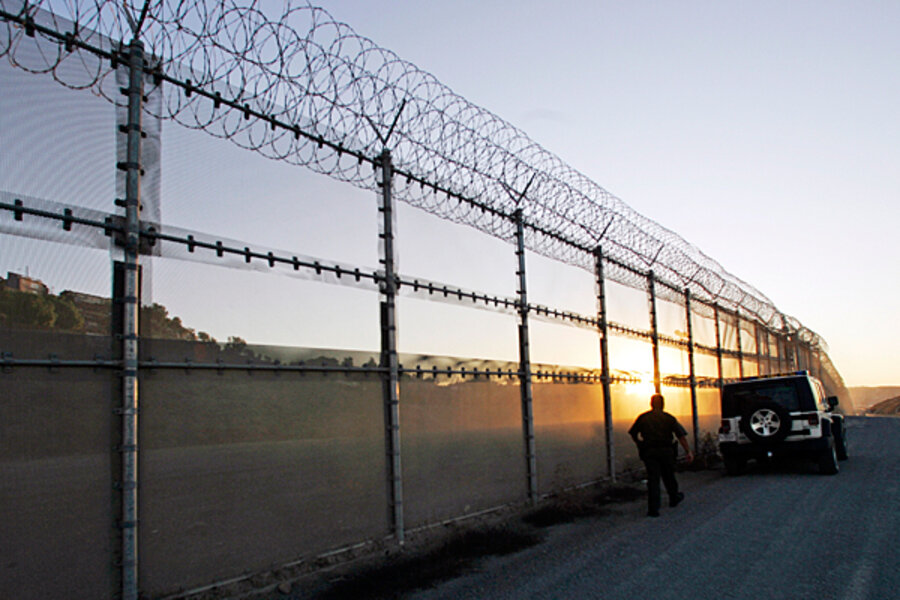At US border, era of fence-building, manpower 'surge' at an end
Loading...
| Phoenix
With apprehensions of illegal immigrants at a 40-year low, the US border patrol is shifting its strategy away from fence-building and a manpower "surge" at the border and toward one centered on intelligence and identifying threats to national security.
To some, the shift is overdue – a recognition that the huge expenses incurred under the former policy are out of proportion to its achievements. To others, it is folly to step back from an approach that, they say, has played a vital role in driving down illegal border crossings.
The new strategy, which border patrol chief Michael Fisher sketched last week for a House panel, is crafted around the idea of risk assessment. It is the clearest indication yet that the Obama administration intends to concentrate on intercepting repeat crossers and other potential threats to national security, according to a recent Associated Press report that included an interview with Mr. Fisher. US officials have said in the past that frequent border crossers may be among the most likely to be involved in criminal smuggling of drugs and humans.
Measures to tackle the growing problem of corruption among border patrol agents are also part of the plan, the AP report said. Moreover, illegal immigrants caught trying to sneak into the US will increasingly face consequences that are more serious than simply being deported. In some areas, including the busy Tucson sector in Arizona, which remains the most popular crossing point, illegal border crossers already face jail time.
Researchers attribute the big decrease in border crossings partly to beefed-up enforcement and partly to a sour US economy and changed migration patterns in Mexico, home to nearly 60 percent of the people living in the US without authorization.
The new strategy is appropriate, given the low numbers of people now coming across the border, says Rick Van Schoik, director of the North American Center for Transborder Studies at Arizona State University in Tempe. “Everyone, I think, has started to recognize that we have the assets that we need, and they need to be more strategically and optimally deployed. That’s one reason you’re not seeing new calls for [more] fencing by most of Congress.”
The border patrol has grown to 21,000 agents, and the US-Mexican border is now fortified with cameras and other high-tech surveillance. In 1996, Congress approved funding for thousands of agents and set aside dollars to extend the border wall. The new strategy does not emphasize new fencing.
Arizona state Sen. Steve Smith, for one, thinks little of the border patrol's new priorities.
“Our federal government, they don’t see the magnitude of this problem,” says the Republican, who in July launched a fundraising website to build a state border fence. “It’s folly … to stop putting up things that we know work, that we know are an impediment,” he adds, saying fencing is part of the solution, along with manpower and technology.
For years, immigrant advocacy groups have pressed for change in border patrol tactics. Tighter border enforcement in California and Texas in the mid-1990s pushed the flow of illegal border crossers to Arizona, where remote desert areas became the top entry point for migrants, some of whom perished making the journey.
“Fences now exist in all but the most remote and impassable areas, the ratio of migrants to [enforcement] personnel is at historic lows, and the ratio of dollars per apprehension is at historic highs,” concludes a yearlong study by the Washington Office on Latin America, a human rights advocacy group, and Mexico’s College of the Northern Border.
“Meanwhile, it is not even clear how much of the reduction in migration owes to security measures – though some certainly does – and how much owes to other factors like recession and fear of organized crime,” states the study, which was released in April. “Additional dollars for current border security priorities will yield little additional payoff and are unnecessary.”
It's evident that heavy funding for the US border patrol is no longer a priority, says George McCubbin, president of the National Border Patrol Council, the union that represents most border patrol agents. Part of the reason is that resources were wasted, he says, on a plan to add $1 billion in technology along the 2,000-mile US-Mexican border to serve as a "virtual" fence.
“It didn’t do anything for the American public,” Mr. McCubbin says of the failed project, known as SBInet.
He also acknowledges a problem with corruption inside the agency, but says agency administrators bear the responsibility. In trying to fulfill Congress’s mandate to hire thousands of agents within a certain time frame, background checks were put off until after agents were already on the job, McCubbin says.
“The negative result of all that is, we hired a bunch of bad people,” he adds. “It’s a concern for all of us.”





